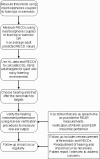Clinical protocols for hearing instrument fitting in the Desired Sensation Level method
- PMID: 16424946
- PMCID: PMC4111495
- DOI: 10.1177/108471380500900404
Clinical protocols for hearing instrument fitting in the Desired Sensation Level method
Abstract
A discussion of the protocols used particularly in the clinical application of the Desired Sensation Level (DSL) Method is presented in this chapter. In the first section, the measurement and application of acoustic transforms is described in terms of their importance in the assessment phase of the amplification fitting process. Specifically, the implications of individual ear canal acoustics and their impact on accurately defining hearing thresholds are discussed. Detailed information about the statistical strength of the real-ear-to-coupler difference (RECD) measurement and how to obtain the measure in young infants is also provided. In addition, the findings of a study that examined the relationship between behavioral and electrophysiologic thresholds in real-ear SPL is described. The second section presents information related to the electroacoustic verification of hearing instruments. The RECD is discussed in relation to its application in simulated measurements of real-ear hearing instrument performance. In particular, the effects of the transducer and coupling method during the RECD measurement are described in terms of their impact on verification measures. The topics of insertion gain, test signals, and venting are also considered. The third section presents three summary tables that outline the hearing instrument fitting process for infants, children, and adults. Overall, this chapter provides both clinical and scientific information about procedures used in the assessment and verification stages of the DSL Method.
Figures











References
-
- American Academy of Audiology (2003). Pediatric Amplification Protocol, Draft American Academy of Audiology.
-
- American National Standards Institute (1997). Methods of Measurement of Real-Ear Performance Characteristics of Hearing Aids. ANSI S3.46–1997. New York: Acoustical Society of America
-
- American National Standards Institute (1996). Specification for Audiometers. ANSI S3.6–1996. New York: Acoustical Society of America
-
- American Speech Language and Hearing Association (2004). Guidelines for the audiologic assessment of children from birth to 5 years of age. http://www.asha.org/members/deskref.journals/deskref/default [retrieved on-line May 2005].
-
- Bagatto MP. (2001). Optimizing your RECD measurements Hear J 54(9): 32, 34–36
Publication types
MeSH terms
LinkOut - more resources
Full Text Sources
Other Literature Sources
Medical
